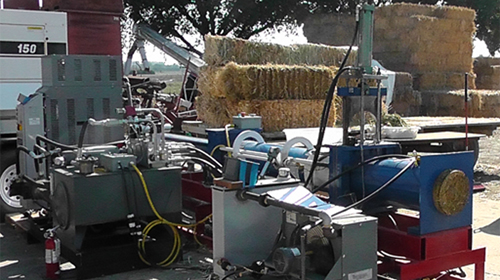Biomass Processing to Fuels
Altex has developed, with the support of DOE, a biomass densification process, called BBADS, that reduces cost by 76% and 84% relative to conventional pelletization and cubing approaches. This field demonstrated system pictured below creates compact biomass logs, shown in the right of the picture, that are ready to be shipped economically to biorefinery sites. These sites can now be located significant distances from the dispersed sites where the biomass is grown. This allows the construction of fewer and larger biorefineries that will then lower the cost of biofuels production, making these biofuels competitive with fossil fuels. To date, BBADS has successfully densified a wide range of materials, including switchgrass, miscanthus, wheat straw, corn stover, and alfalfa, with some examples pictured below on the right. Densities as high as 50lb/cf are possible with BBADS—see the examples below
Another Altex innovation under development, with the support of DARPA, DOE and the Army, is a solid to liquid fuels conversion process that can convert biomass or housing (e.g. paper; cardboard, plastic) wastes into a drop-in and infrastructure compatible fuel. Depending on the process parameters, either a jet or gasoline-like fuel can be produced. The figure to the immediate right illustrates the jet-like fuel that meets all relevant JP-8 specifications. Unlike alternative conversion processes, this process uses targeted intermediates as a base to create the final fuel form through catalytic reactors that have been developed in collaboration with PSU. By not converting the feedstock all the way to a syngas, nor simply using pyrolysis to generate a crude feedstock, the process targets the optimal level of processing to minimize costs. To date, tests have shown the capability of the process to successfully convert wood waste, housing waste, switchgrass, and wheat straw, as well as low rank lignite and sub-bituminous coals, into liquid fuel. Based on the successes of the laboratory tests, the process is being scaled up for planned tests that will further demonstrate the process.
This figure illustrates the jet-like fuel that meets all relevant JP-8 specifications. |
 |
Unlike alternative conversion processes, the CAMBS process uses targeted intermediates as a base, to create the final fuel form through catalytic reactors, which have been developed in collaboration with PSU. By not fully converting the feedstock to a syngas, nor simply using pyrolysis to generate a crude feedstock, the CAMBS process targets the optimal level of processing, to minimize costs. To date, tests have shown the capability of CAMBS to successfully process wood waste, housing waste, switchgrass, and wheat straw, as well as low rank lignite and sub-bituminous coals. Based on the successes of the laboratory tests, the process is being scaled up to pilot-scale, for planned tests, which will further demonstrate the process.
 |
Alfalfa log |  |
| Corn stover log |  |
|
| Switchgrass log |  |
